The Universe

What is galactic evolution?
There appears to be some evidence of a possible evolutionary progression among the types of galaxies such as normal galaxy radio galaxies, Seyfert galaxies and even some other bodies such as quasars. However, galactic evolution has not been conclusively proved and is still undergoing investigation.

What happens when two galaxies collide?
In spite of the colossal mass of stars and space debris contained in galaxies the mass is very highly dispersed. Though several colliding galaxies have been studied, there does not seem to be any evidence of catastrophic impact.
However, due to the tidal forces, the total masses of both galaxies are redistributed between them, though the two nuclei are comparatively less affected.

What is the Messier List?
The Messier List or Messier Catalogue represents the first attempt to publish a catalogue of heavenly bodies difficult to identify, and contains particular of 109 such objects including remote nebulae and galaxies. The list was prepared to forewarn astronomers who were constantly mistaking these for comets and stars.
What is the Messier Number?
The Messier Number is the identification code of a heavenly body in the Messier Catalogue. An example is the Andromeda galaxy designated as M31.



















